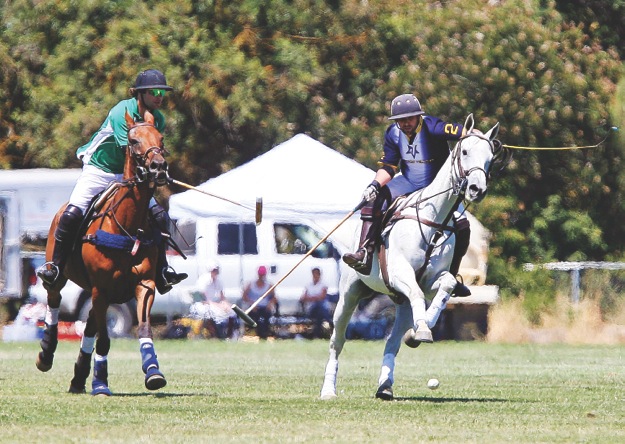
Sitting horseback in an open, neatly mowed field that spans 300-yards long and 160-yards wide, eight people, each holding a long mallet, wait patiently for a man dressed in a black and white striped shirt to toss a white plastic ball onto the grass.
As the ball rolls between the hooves and legs of eight horses, the peace and tranquility turns into an adrenaline-pumping thundering sound and a seemingly chaotic mess. As the white ball sails down the grass, the galloping horses, and the riders on their backs, take off after it.
And with that, for the first time in nearly six years, the game of polo was back in Gilroy.
For the next seven and a half minutes – called a chukker (similar to a quarter in football or basketball) and one of four in a polo match – the two teams – four riders per team – attempt to hit the ball to one end of the field. It’s the ceremonious start to the “Sport of Kings,” something that may be foreign to some of us in the 21st century, but not to those gathered at Buck-n-Horse Ranch in Gilroy on Saturday.
It’s the first of many days of its kind at South Bay Polo, which officially opened its doors to the public with an open house and polo exhibition Saturday.
The club, owned by Tim Westin, aims to bring more people to the sport that is steeped in American tradition, Westin said.
“We are here to introduce polo to the south bay and to bring those that play polo and want to learn how to play polo out here,” he said. “We have everything they need available to them. We have the place and trainers ready for them.”
The game of polo dates back to the 1800s in the United States when it was imported from England.
Much like hockey, there is contact and teams aim to score into one of the goals at the end of the course.
The first official polo match was held in New York City on May 6, 1867. Since then, polo has been played in five Olympic Games and is a professional sport in 16 countries. Today, its popularity has waned – a trend Westin hopes to halt at South Bay Polo.
Westin, who bought into the ranch in 2010 to reestablish polo in the area, hopes the club can be the start of a revitalization of the sport, he said.
After one day, so far it’s working, ranch co-owner Gary Pollack said.
“This is his opening day and he has plenty of people. Hopefully, it will continue,” said Pollack, who ran the Silicon Valley Polo Club from 1999 until it folded in 2006. “It’s great. It’s a great thing. I hope enough people support it. It’s just fun. The adrenaline rush you get. You love horses obviously. There is nothing like it. It’s great. It’s just up to the members. It’s up to the participants to support it. I encourage people to come out and watch the polo.”
South Bay Polo isn’t just aimed for those with polo experience and horse owners. It’s for everybody, member Terry Reilly said. The club offers a 10-week training program that costs $1,000 and includes the horse and trainer. Once trained, players can pay $35 per a seven and a half minute chukker and $100 to rent a horse.
“Polo is not an instant gratification sport and that’s why it takes 10 weeks to learn it and riding is 80 percent of it,” club manager Francesca Finato said. “Most of it is teaching you how to ride before you swing a mallet. By the end of the 10 weeks, you’ll be out there playing polo. It’s a lot of fun and it’s an incredible adrenaline rush.”
It a sharp-but-easy-to-grasp learning curve, Reilly said.
But if playing isn’t in the cards, watching comes next. Tickets are free to watch the games, which will be played at 5 p.m. Thursday and 10 a.m. Saturday.
Reilly first started riding horses in December after his son, who graduated from Yale in May, started playing the sport at college.
After watching his son on the sideline, the 50-year-old Reilly decided to pick up the sport himself. Six months later, he is having the time of his life, he said.
“It’s pretty amazing being on a horse,” Reilly said. “It’s the only team sport where you rely on an animal and this animal travels at 25-30 mph and is 1,500 pounds. There is a lot of adrenaline. Once you see it, it is pretty amazing. You are going to be leaving from here and going, ‘You know, I think I want to try this.’”
Once it’s experienced, people will want to come back, Reilly said.
“Everybody gets stuck in their habits,” he said. “They go to church, they go to the farmer’s market, they go to lunch and they go do their gardening chores. Then the next Saturday, they go to the famer’s market and do the same things. But they should go ‘oh, there is polo just five minutes away lets go check it out.’ You can picnic and watch polo. You are going to watch this and … when they run by and feel the ground shake, you’ll want to come back.”









